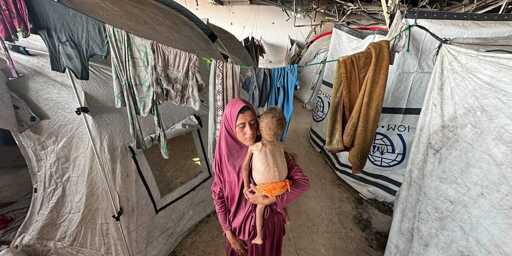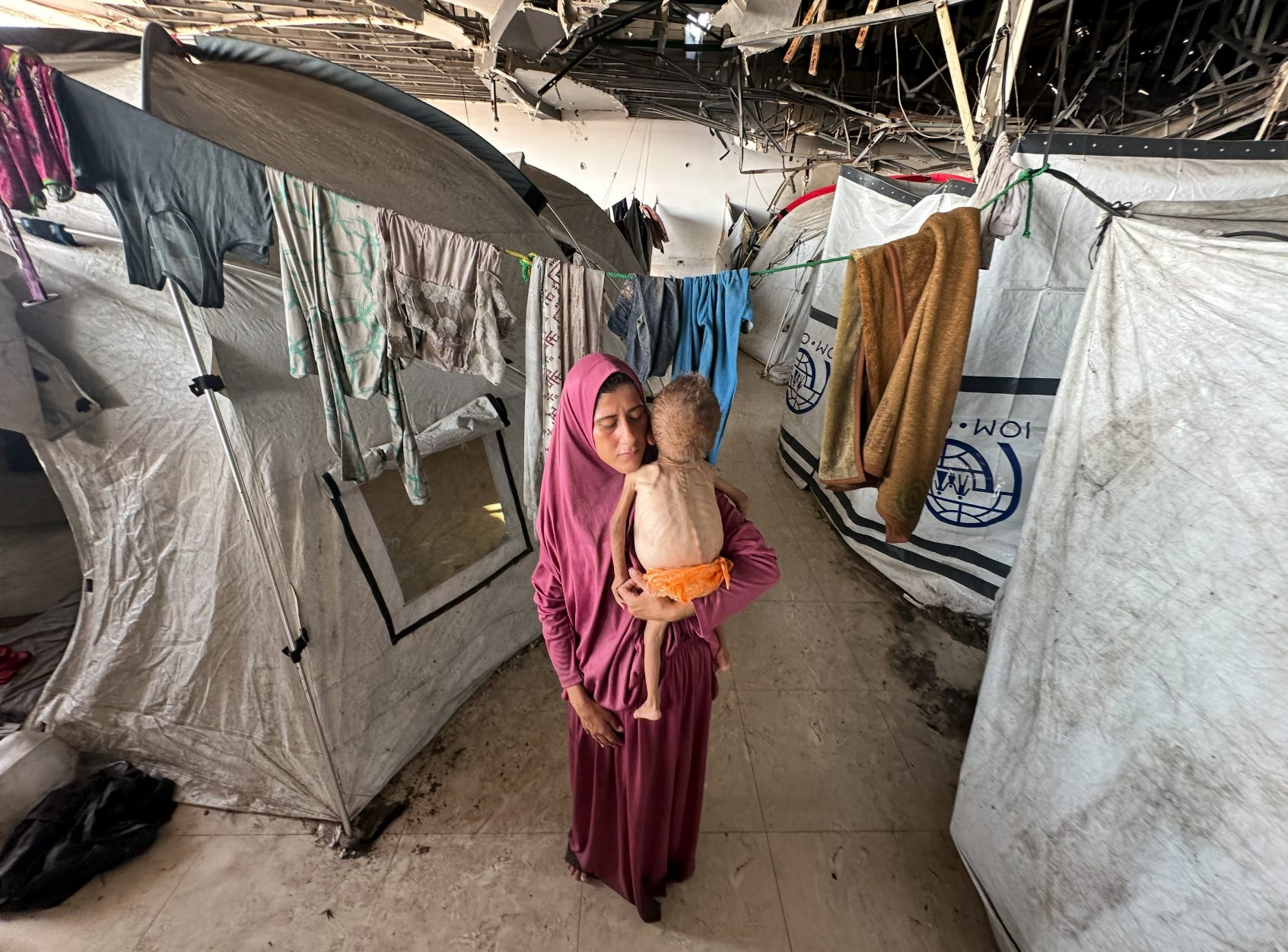Muhammad Zakariya Ayyoub al-Mutawaq and his mother, displaced. Photo credit: Hani Ashraf Abu Rezeq.
Story by Maha Hussaini and Ryan Grim
GAZA CITY—In August, The Free Press (FP), a news organization acquired Monday by Paramount for roughly $150 million, announced that it had conducted an investigation into the cases of a dozen Palestinians whose photographs were published in mainstream U.S. media outlets as examples of starvation and malnutrition in Gaza. That investigation, which the FP used as evidence the famine in Gaza is overblown, was woefully incomplete.
On Monday, FP founding editor Bari Weiss was named editor in chief of CBS News, and pledged in an email to staff to bring a sense of journalistic rigor to the newsroom. In an unusual setup, Weiss will be reporting directly to Paramount Skydance chairman and CEO David Ellison rather than up through the news division. If the FP probe into the dozen Palestinians is any indication of what’s to come, the editorial standards at CBS News may be about to collapse.
The Free Press claimed dereliction on the part of the mainstream media. “We did something so simple it’s shocking that no other journalist bothered to do it,” announced FP reporter Olivia Reingold, describing how she and her colleague Tanya Lukyanova used Google to search for news articles and interviews about the children featured in photographs. “[I]n every instance, they were already facing grave situations because of their health, irrespective of any third-party action,” the outlet reported.
“In leaving out that context, the outlets presented an incomplete story,” The Free Press wrote in an editorial defending their coverage. “We are proud of the report and the reporters who tracked it down. In doing so, Olivia Reingold and Tanya Lukyanova performed a public service.”
The investigation represented journalism at its finest, the outlet argued. “In a normal time, this is the kind of work that would be praised by our peers for getting to ground truth,” reads the editorial, calling the Google-based investigation “sober, meticulous work.” Weiss and other FP writers even touted the article as an example of the virtues of their approach to journalism in a series of lectures.
David Ellison, heir to the fortune of his father, Oracle founder Larry Ellison, is said to have been attracted to Weiss and The Free Press specifically for the outlet’s pro-Israel stance. Dylan Byers, who broke news of the FP sale for Puck, reported that Ellison was “smitten by Bari’s unwavering support of Israel and preoccupation with the rise of antisemitism—issues that are as near and dear to David’s father, Larry, as they are to Paramount’s outgoing owner.”
Facing blowback for minimizing the famine in Gaza, The Free Press responded by saying that critics of the article, including Drop Site, are “journalists who oppose actual journalism.”
Weiss added: “You’ll notice one important aspect about the uproar: No one is disputing the facts in our piece.”
Well, we are. The Free Press claims in its investigation to have looked at the cases of 12 Palestinian’s photographs, as well as the child, Muhammad Zakariya Ayyouba Al-Mutawaq who appeared prominently in a New York Times article—and whose story they questioned in a previous Free Press article. Yet instead of reporting on the 12 Palestinians they claimed to have looked into, the article in fact only addresses nine, or arguably ten, an inexplicable discrepancy, and doesn’t provide original reporting on any of the cases.
Drop Site asked FP reporter Reingold and editor Weiss if the outlet attempted to contact any of the people or their family members whose health conditions they reported on. Neither responded to a request for comment.
The FP article probed the cases of nine Palestinians: Maryam Dawas, Youssef Matar, Hamza Mishmish, Najwa Hussein Hajjaj, Mosab al-Debs, Atef Abu Khater, Abdullah Hani Muhammad Abu Zarqa, Karam Khaled Al-Jamal, and Osama Al-Raqab. It also references another unnamed case, saying the Washington Post published an outdated photo of a malnourished child, which Drop Site identified as eight-year-old Jana Ayad.
For Drop Site, Gaza-based journalist Maha Hussaini looked into the backstories of those cases highlighted by the Free Press to examine whether the claim—namely that starvation did not drive their deteriorating health condition—was accurate. Hussaini tracked down families of three of them before her reporting was cut short by her own forced displacement from Gaza City amid a concentrated Israeli military offensive: Muhammad Zakariya Ayyoub al-Mutawaq, Najwa Hussein Hajjaj, and Hamza Ismail Mishmish.
What she found is that their underlying health conditions did not drive the deterioration of their health. Instead, it was the lack of access to food and medicine that drove their acute medical crises. Such is the hallmark of a famine. The first to fall victim are generally those who had underlying conditions to begin with; those Palestinians were managing their conditions before the restrictions took hold, but the starvation drove their decline. Additionally, it is difficult to separate their underlying health difficulties from the conditions under which their mothers lived while pregnant and in the first weeks and months of their lives.
The fact that so many children in Gaza have such pre-existing conditions by no means exonerates the Israeli siege, but rather is further evidence of its harm. While Gaza has been under an Israeli blockade since 2007, Israel began severely restricting the amount of aid allowed into Gaza in October 2023. On March 2 of this year, Israel cut off all entry of food, medicine, fuel and other supplies, only partially lifting the blockade in late May, while continuing extreme restrictions. By the summer, starvation was widespread. By late August, the Integrated Food Security Phase Classification, the world’s leading expert on food crises that is used by the UN, declared the governorate of Gaza to be in the grip of the most extreme form of famine, the severity of conditions in North Gaza governorate to be similar or worse, and the thresholds for famine in the Deir al-Balah and Khan Younis governorates soon to be crossed.
The families spoke to Drop Site openly about the medical histories of their children and siblings and shared before-and-after photos and other evidence to back up their claims. That any parent would have to do so is its own injustice and indignity—an insult on top of the injury they are already suffering.
But it’s important to do, particularly as the work Bari Weiss has done at The Free Press will now be supercharged with an infusion of resources. What she considers to be legitimate journalism takes on increased import.
Drop Site News is reader-supported. Consider becoming a free or paid subscriber.
Muhammad Zakariya Ayyoub al-Mutawaq
The child at the center of the controversy amplified by the FP is Muhammad Zakariya Ayyoub al-Mutawaq, who is now 22 months old. Under pressure, The New York Times posted an update to a July article featuring the child: “After publication of the article, The Times learned from his doctor that Mohammed also had pre-existing health problems.”
Additional context, however, demonstrates that Israel’s assault on and siege of Gaza was in fact more responsible for his condition, not less. His difficulties began even before he was born. In the final two months of her pregnancy, his mother, Hedaya al-Mutawaq, was subject to relentless Israeli bombardment in Jabaliya, in northern Gaza, and forced to displace multiple times. Eventually, she gave birth to Muhammad, her second child, during one of Gaza’s harshest nights of attacks in December 2023.
The baby was born with slight muscle weakness and an apparent neurological condition. But despite the dire conditions in Gaza, his parents ensured he received extensive medical care, including several physiotherapy sessions. “He showed remarkable progress that even doctors found surprising. He began to sit alone, then crawl, and eventually stand on his own,” Al-Mutawaq told Drop Site.
For Muhammad to continue his healthy development, he either needed nutrition from his mother or through supplements specifically designed for infants. Breast feeding became impossible as his mother faced malnutrition as a result of the lack of food available in Gaza. “I suffered from malnutrition around two months after I gave birth to him, and he stopped breastfeeding,” his mother said. “At that time, his father was still with us and could acquire milk, so despite the harsh conditions, Muhammad began growing as a healthy child. At one point, he was even chubby.”
Muhammad’s father, Zakariya, was killed in an Israeli attack on Deir al-Balah in central Gaza on October 28, 2024, before Muhammad turned one.
After her husband’s death, Al-Mutawaq struggled to secure basic necessities for her children.
“I couldn’t consistently get milk or diapers, but people continued to support me, bringing milk from time to time. I was still able to provide food for him until the occupation sealed the borders and enforced starvation in March,” Al-Mutawaq said.
When Israel imposed a full-spectrum blockade in March, Muhammad was just 15 months old. “Until the end of March, Muhammad’s health was still good, he weighed around nine kilograms. But since then, his health has deteriorated week by week. He lost roughly one kilogram every month. Today, at 19 months old, he weighs only six kilograms,” she said, showing Drop Site photographs and videos before and after.
Muhammad was admitted to the hospital for several days and diagnosed with severe acute malnutrition, the most extreme and life-threatening form of malnutrition.
“They say that the skeletal body of Muhammad is due to another health condition,” Al-Mutawaq said. “But if so, why isn’t this skeletal body visible in his photos only a couple of months ago? Why did he become like this only after Israel started starving us?”
The family has also come under scrutiny due to a photograph of Muhammad’s older brother, whose malnutrition did not appear to be as severe. His mother insists that his brother also suffers from malnutrition.
“His brother is older, and we could feed him whatever was available. Even so, he lost much of his weight, and his spinal cord began to show. Muhammad, however, needed milk and baby formula that were completely unavailable,” Al-Mutawaq explained.
“No one in our family looked like this before the starvation. We all weighed more and were healthier, even though we had been enduring a starvation policy since the beginning of the war. The one that began in March was by far the harshest.”
After the New York Times, under pressure, updated its story to note the pre-existing medical condition, the FP described the report as “beginning to unravel,” subtitling their story, “The paper’s blockbuster story on Gaza starvation gets a correction [sic]. But the damage has already been done.”
Najwa Hussein Hajjaj
While The Free Press claimed it looked into “viral” images of starvation in Gaza, they were not all viral. A photo of Najwa Hussain Hajjaj, for instance, was just one from a slideshow that accompanied a CNN article.
Hajjaj, a six-year-old girl from the Shejaiya neighborhood in eastern Gaza City, was diagnosed with severe malnutrition following months of Israeli military attacks and the tightening blockade.
Citing Hajjaj’s parents in an interview with Al-Araby Al-Jadeed, The Free Press suggested that her esophageal stenosis, rather than Israel’s imposed starvation, was responsible for her condition.
However, Drop Site interviewed her mother, who is currently accompanying her on a medical evacuation in Jordan, to clarify her exact condition.
“Before the war started, we had taken her to the hospital, and she was diagnosed with esophageal stenosis. Her condition had not yet worsened, and a surgery was scheduled for December 4, 2023,” said Islam Hajjaj, Najwa’s mother. “But of course, with hospitals being bombed, others overwhelmed with victims, and a lack of equipment, her surgery was canceled. This is when our own war with her condition began.”
Hajjaj said that her child started vomiting and was unable to eat, while no supplements or medical fluids were available to compensate for the food she could not consume.
“Doctors told us that medical fluids were not always available due to the complete closure. They could provide some fluids only when her condition worsened, just to keep her alive. But because of the overwhelming number of children suffering from malnutrition and the scarcity of medical supplies, they could not administer fluids consistently,” she added.
“We tried to secure her proper food for her condition like pureed vegetables, yogurt, juice, or soft cheese, but none of these was available during the starvation campaign. We couldn’t secure anything but lentils.”
The girl’s parents desperately tried to arrange surgery for her, but none of the hospitals across the Gaza Strip had the necessary equipment, as Israel restricted medical supplies from entering.
According to her mother, she was finally admitted for a medical evacuation in July, after many long months of trying to evacuate her for treatment. Since then, she has undergone three surgeries.
Hamza Ismail Mishmish
The Free Press doubted the credibility of an NPR article published on July 29, arguing that the emaciated body of 25-year-old Hamza Ismail Mishmish, from Nuseirat refugee camp in central Gaza, was actually the result of pre-existing health conditions, citing a previous interview his mother gave to the Palestinian state news agency Wafa.
Drop Site approached the family for further details on Mishmish’s condition and confirmed that while he does suffer from cerebral palsy, this was not the reason his health had rapidly deteriorated over the past months.
“Hamza was born with cerebral palsy and congenital anomalies and had lived with this condition for years. We used to follow up with doctors, and he survived all these years on nutritional supplements and vitamins,” Shadi, Mishmish’s brother, told Drop Site.
“During the war, we faced difficulties securing his nutritional supplements, and it was impossible to compensate with fresh food. With the borders closed, and even when international aid was allowed in, all we could find was canned food. But in the recent months of starvation, his condition rapidly deteriorated.”
Shadi added that although his brother’s body appeared thin before the war, “one can clearly see the difference between how he looked then and how he looks now.”
“The recent starvation made us completely helpless towards his condition. Food supplements were completely unavailable, even canned food disappeared, and we couldn’t even secure wheat flour for bread,” he said.
Mishmish’s condition is not able to withstand prolonged malnutrition, his brother said: “Hamza’s body is weak; he is like a baby in the process of building muscles. He constantly needs vegetables, meat, fruits, milk, and eggs. If he goes without proper nutrition for a prolonged period, his muscles are severely affected, and his entire body begins to break down.”
Since Israel sealed the Gaza Strip’s borders on March 2, even the partial openings since late May for international aid and goods have not allowed meat or eggs to enter.
On just two occasions, limited amounts of frozen chicken reached southern Gaza, but with prices soaring to around $100 per chicken, the vast majority of residents could not afford it.
Mishmish’s family added that his health has been further worsened by the family’s conditions in displacement, forcing him to live in a makeshift tent after their home was bombed.
“This tent cannot protect him from the scorching heat in summer or the freezing cold in winter. In cold weather, we cannot keep him warm, so his body develops infections, his feet swell, and his entire body weakens. We would need at least three weeks to help him recover from these symptoms,” Shadi continued.
“All of these circumstances combined are why his body has never been the same since the war.”
When it comes to the others cited in the FP article, elementary scrutiny, even without direct interviews with parents or friends, sheds light on the FP’s reporting. Though the FP says all the people it investigated were facing serious issues “irrespective of any third-party action,” Mosab al-Debs, a 14-year-old teenage boy, had part of his skull removed due to an injury caused by an Israeli shell explosion, which the FP cites. The Israeli military, of course, is not a “third party” to the conflict.
Indeed, in all these cases, it could be said that the children and adults suffering from malnutrition and starvation had a universal complicating factor: Israel’s attacks on their very way of life.
From Drop Site News via this RSS feed



